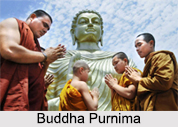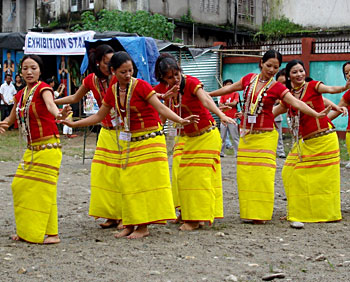 Car Festival of Mayurbhanj District, Odisha is also popularly known as the `Ratha Yatra` or the Car Festival of Baripada and it is believed that this grand festive occasion can be ranked second only next to the Ratha Yatra of Puri. Three large chariots or `Rathas` carrying the idols of Subhadra Devi, Lord Balabhadra and Lord Jagannath adorn the town of Baripada during the festive days. Innumerable devotees throng this Indian district to witness the Car Festival of Mayurbhanj, which continues for nine days. The pilgrims who assemble here believe that if they touch the sacred rope of the Ratha holding Lord Jagannath, they would be liberated from the miseries associated with `rebirth` and be unified with the ultimate immortal soul and divine energy of the `greatest creator of the universe`. Also termed as the `Ghosh Yatra`, the Ratha Yatra is observed with intense spiritual fervour, and immense gusto by the regional residents of Mayurbhanj District in Odisha. The builders commence creating the chariots on the day of the `Akshaya Trutiya`, also referred to as `Chukla Trutiya` of the day of `Baisakha`.
Car Festival of Mayurbhanj District, Odisha is also popularly known as the `Ratha Yatra` or the Car Festival of Baripada and it is believed that this grand festive occasion can be ranked second only next to the Ratha Yatra of Puri. Three large chariots or `Rathas` carrying the idols of Subhadra Devi, Lord Balabhadra and Lord Jagannath adorn the town of Baripada during the festive days. Innumerable devotees throng this Indian district to witness the Car Festival of Mayurbhanj, which continues for nine days. The pilgrims who assemble here believe that if they touch the sacred rope of the Ratha holding Lord Jagannath, they would be liberated from the miseries associated with `rebirth` and be unified with the ultimate immortal soul and divine energy of the `greatest creator of the universe`. Also termed as the `Ghosh Yatra`, the Ratha Yatra is observed with intense spiritual fervour, and immense gusto by the regional residents of Mayurbhanj District in Odisha. The builders commence creating the chariots on the day of the `Akshaya Trutiya`, also referred to as `Chukla Trutiya` of the day of `Baisakha`.
The different festivities of the Ratha Yatra involve pulling of chariots on `Ashadhya Truitiya` and `Chaturthi`, `Uvayatra` which is celebrated during `Ashadhya Shukla Pratipada`, pulling of `Bahuda` chariots during `Ashadha Dwadashi` and `Trayodashi`, `Bahuda Yatra` and `Pahandi` during the occasion of `Ashadhya Shukla Ekadashi`, `Pahandi` at `Ashadhya Shukla Dwitiya` and `Netra Utsav` during `Ashadhya Krushna Amabasya`. This festival has been observed ever since 1575 AD and the three deities arrive in their chariots just following Pahandi, and pilgrims start pulling these chariots the very next day. The 14-wheeled chariot of Lord Balabhadra, which is also called `taldhwaja` is the first chariot or Ratha to be pulled and its destination is the `Mausi Temple`. Then, the 12-wheeled chariot of Devi Subhadra, also known as `Devidalan` is pulled, particularly by the womenfolk. Generally, this chariot proceeds half the way and is stopped as a practise, close to the police station of the town. The three chariots are stopped during the night, for the purpose of ensuring their safety.
The following day, the chariots are again begun to be escorted and Devidalan approaches Mausi Temple. Immediately thereafter, the 16-wheeled chariot of Lord Jagannath or the `Nandighosh` is started, amidst accompanying sounds of conch shells or `Ghantas`. It sways majestically and occupies the majority of the path. Similar rituals are followed on `Ashar Shukla Ekadashi` or the `Bahuda Day`, and finally the rite of pulling the chariots is accomplished within a period of two days. Since there is hardly any excess space left for the Rathas to rotate, the alternate pattern is observed during the return journey and Nandighosh or the chariot carrying Lord Jagannath is the first chariot to be pulled. This is followed by the chariots of Devidalan and finally the Taladhwaja respectively.
As per Hindu mythology, there are various `Vesha` on the different days while Lord Jagannath, Lord Balabhadra and Devi Subhadra are in Mausi`s Temple which include `Ananta Vasudev` on the very first day, `Luxmi Narayan` on the second day, `Vishwarupa Mahadev` and `Kaliya Dalan` during the third day, `Kali` and `Nrusingha` on the fourth day and finally `Kalaki` and `Baman` on the 5th day of the Ratha Yatra.



















